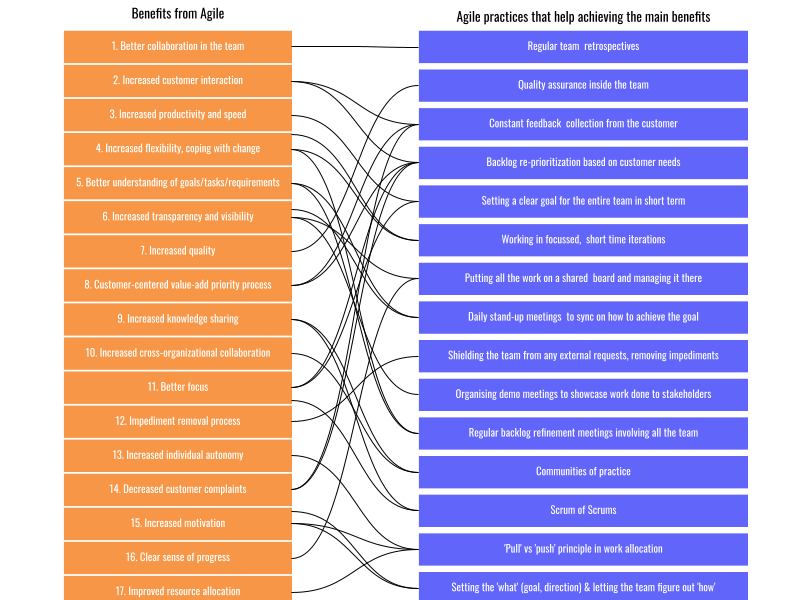17 Benefits From Working in Agile
And some practical advice on how to achieve them
Since the inception of the Agile Manifesto in 2001, working in ‘Agile’ has come to mean many different things. This has meant adopting one or the other Agile framework for some teams. In contrast, others have promoted improving business Agility and the Agile way of thinking (i.e., being Agile vs. doing agile). However, empirical studies report 17 concrete benefits of working in Agile:
- Better collaboration in the team
- Increased customer interaction
- Increased productivity and speed
- Increased flexibility, coping with change
- A better understanding of goals/tasks/requirements
- Increased transparency and visibility
- Increased quality
- Customer-centered value-add priority process
- Increased knowledge sharing
- Increased cross-organizational collaboration
- Better focus
- Impediment removal process
- Increased individual autonomy
- Decreased customer complaints
- Increased motivation
- A clear sense of progress
- Improved resource allocation
Below is a summary of how Agile teams achieve these tangible benefits in practice.
Better Collaboration In The Team & Increased quality
Agile teams widely apply the concept of ‘inspect and adapt.’ This also applies to the way how a team works together. In practice, Agile teams make time to retrospect and review how the team works together. Any problems in teamwork and collaboration surfaced, and improvement ideas were agreed upon. Furthermore, Agile teams often document how they shall collaborate – their ‘ways of working.’ Those are regularly reviewed and tailored to improve the efficiency and the way the team collaborates..
The principle of ‘inspect and adapt’ applies to team collaboration and the actual tasks an Agile team is working on. Having quality assurance conducted on all tasks is a standard practice in all Agile teams. A dedicated team member can conduct the quality assurance, which sometimes might create an internal dependency (and a bottleneck). Thus, Agile teams often share the quality assurance tasks among the team members (review and verify each other’s work) and seek ways to automate the quality assurance.
Increased Customer Interaction, Customer-Centered Value-Add Priority Process, & Decreased Customer Complaints
The Agile Manifesto noted that feedback from and collaboration with customers is more important than trying to guess what customers want. For Agile teams, customer feedback is the North Star – the mission and vision are aligned to solve customer problems. Customer needs likewise determine what Agile teams will prioritise in their backlogs. This principle is called ‘customer-centricity.’
Often (product) managers of Agile teams spend most of their time in the fieldwork – meeting the customers, discussing their routines and habits, and seeking the pain points and ways to help them. Agile teams also develop other mechanisms for a constant feedback loop from the customers. Those range from semi-automated ones (e.g., using feedback tools like Feedback Fish) to automated ones (tracking user activity during their interaction with the product, e.g., using Hotjar).
All the collected data on customer needs then translates into business and technical requirements that constitute the team’s backlog. The team focuses on building things that benefit the customer’s competitive advantage.
Increased Productivity And Speed, Better Focus, Impediment Removal Process, Increased transparency, And visibility, & Clear Sense Of Progress
Increased productivity and speed in Agile teams usually come from limiting distractions. Teams often work in short single goal-oriented time iterations and are shielded from external requests. Working on a single task at a time is also often promoted to reduce the time lost on context switching. This requires a certain level of discipline in the team – members have to know how to manage any unwanted, ad-hoc requests and team leaders have to proactively look after that nobody disturbs the team and that the goal orientation is maintained from day to day. Often protecting the Agile team from external distractions and removing any impediments from its way takes a significant portion of the manager’s daily job routine.
On the inside – teams apply the principle of ‘make all the work visible’ and ‘no hidden work’. All tasks the team plans to work on are usually written down and managed on a physical or virtual board with a specific workflow (e.g., using tools like Trello or Jira). The team is only working on what is on the board. And daily, an Agile team comes together for a short stand-up meeting to review the pending tasks and discuss how to collaborate better to achieve the main goal.
Transparency and visibility are championed by Agile teams also externally – they are eager to demonstrate the completed work (after each work iteration) to get feedback from customers and stakeholders. Thereby, Agile teams maintain constant visibility of what the team has completed.
Increased Flexibility, Coping With Change
Breaking down larger initiatives into smaller, manageable tasks allows Agile teams to avoid getting stuck on something half-completed when plans suddenly change. There are even specific backlog breakdown techniques that teams regularly apply when they refine future work.
Another way to increase flexibility is to work in short time iterations – plan the work to be done only for the next 1-4 weeks. After each iteration, the Agile team reviews what has been done and plans the next iteration. The team’s direction can change 180 degrees if needed, which will not damage the team’s productivity because it has been used to set new goals regularly. One of the most popular Agile frameworks applying this technique is Scrum (also the most popular Agile framework in the World).
Better Understanding Of Goals/ Tasks/ Requirements
A better understanding of something requires immersing oneself in a topic and having an opportunity to inquire for more information and discuss the topic with others. Agile teams regularly come together and refine future work in refinement meetings. This is where the author(s) of tasks presents the tasks at hand, and others can ask any questions. The trick is to involve all team members in these discussions. Even if other team members may seem less relevant for the discussion because they will not be involved in the execution of one or the other task – their presence in the refinement discussions will contribute to a better understanding of the topic in the entire team. If the task assignee suddenly becomes unavailable – the rest of the team will have the capacity to compensate – collaborate, and execute the task.
Increased Knowledge Sharing & Increased Cross-Organisational Collaboration
Knowledge sharing inside Agile teams is fostered via open and visible backlogs and the above-mentioned backlog refinement meetings. However, often team members want to share knowledge outside – with other teams. For that purpose, members from Agile teams form communities of practice – these are informal groups of people with similar professional interests (or backgrounds) that regularly meet to share knowledge, new learnings, and achievements or agree on common approaches. Communities of practice are like discussion clubs for like-minded professionals – they provide Agile team members with the space to widen their industry knowledge and advance their professional development.
Besides the communities of practice, Agile teams learn to collaborate with the rest of the organisation in a structured way. While Agile teams are usually independent and cross-functional (don’t depend on any other team to deliver value), sometimes, when working on larger initiatives, some alignment is required with the rest of the organisation. The demo sessions create an opportunity to get feedback from the stakeholders (one-directional). However, they do not create alignment with other teams (requires two-directional communication). A common practice for Agile teams is to nominate a representative (often – a rotating role in the team) from each team for a regular alignment meeting between the teams. The representative is responsible for representing the team’s interests and bringing back and sharing the information from the alignment meetings with their team. In this way, cross-organisational collaboration is achieved while maintaining teams’ autonomy. In scaled Scrum frameworks, this meeting is called Scrum-of-Scrums.
Increased Individual Autonomy, Increased Motivation, & Improved Resource Allocation
An important principle Agile teams follow is counter-intuitive to the traditional top-down management approaches: team members are asked to select what they will work on. Agile teams call this a ‘pull’ principle – team members ‘pull the work’ they want to do from a prioritised backlog – in contrast to being pushed to work on something by the management. It is part of the objective to achieve an aligned autonomy – i.e., having an alignment around a certain goal while preserving the team’s and team members’ autonomy to decide on how to achieve the goal. It is also much more logical from the team’s perspective since they know what skills, capacity, tools, and know-how will be available to them in the next iteration.
In practice, teams that work in short time iterations have an iteration goal set by a leader or manager, but then the group is invited to collaborate and figure out how they will achieve this goal. The ‘how’ part is left to the team (team’s autonomy), while the ‘what’ (the direction) part is usually determined by the leadership and business objectives. In the long run, embedding the power of independence in the team is highly motivating because it creates a notion of self-determination.

The widely reported benefits of Agile are a product of hard work and concrete Agile practices that are put in place in a company. Often professionals like Agile Coaches help the teams to roll out and sustainably embed these practices. Continuous attention is required for implementing Agile practices because neither the team dynamics nor the application of the practices is a constant. Twisting and tweaking Agile practices in teams is a never-ending process, but the benefits are worth it.







